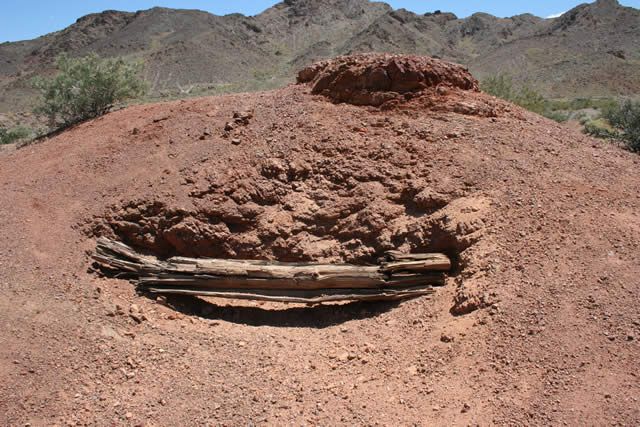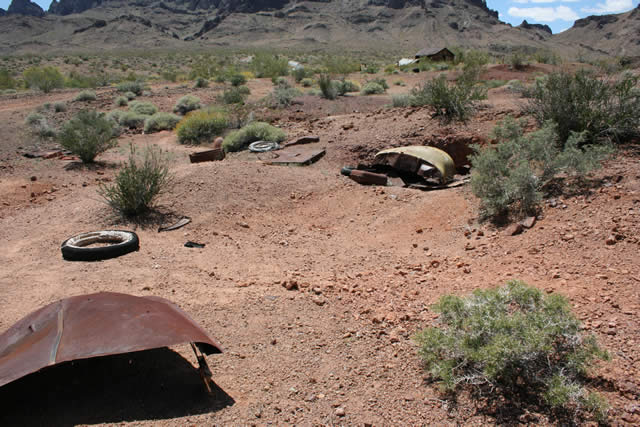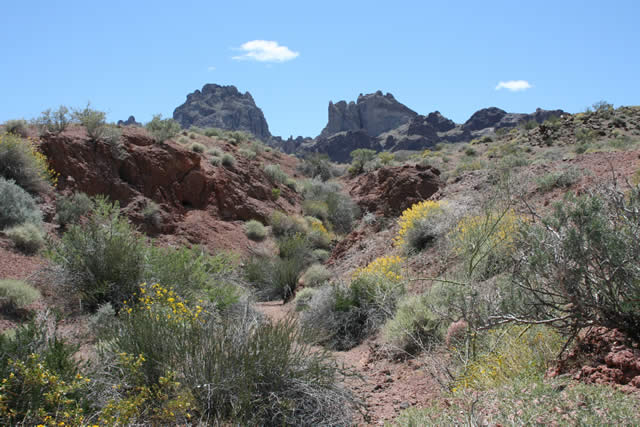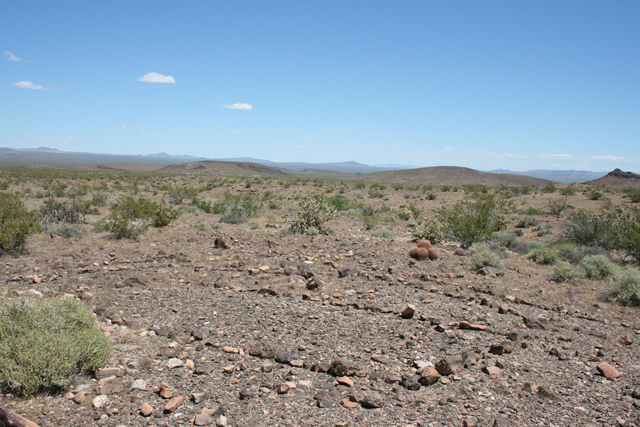![]() News.bytes Extra, issue 436
News.bytes Extra, issue 436
Remote Lost Arch Historic Mining Camp benefits from ARRA funding
On the edge of the remote, but scenic, Turtle Mountains Wilderness and National Natural Landmark, the intrepid desert traveler can discover the remains and toils of prospectors long ago. Among the relics, until recently, an unsuspecting hiker on the old and deteriorated Mexican Hat Trail could have stumbled onto or into any of 10 potentially deadly mine shafts. Outside the range of cell phone service, the region is so remote and rarely visited, unlucky hapless adventurers could become bleached white skeletons before anyone discovered their misadventures. (text continues below)

Charley Brown's Lost Arch in was never an inn -- but was long "the center of a desert wonderland ...."
These hazards were among those in the California Desert made safer by funding from the American Recovery and Reinvestment Act. Additionally, the funding is making possible the establishment of primitive camping sites in the Lost Arch Historic Mining Camp, as well as the renovation of the Mexican Hat Trail.
The Lost Arch Inn, according to a 1948 issue of The Desert Magazine, “does not supply food or lodging… It never was an inn and the arch for which it was named is not lost. But the isolated camp established by Charley Brown is the center of a desert wonderland for lost mine hunters, rockhounds, botanists and those who like to follow forgotten trails through scenic canyons.”
Mona Daniels, BLM’s project manager for the restoration, says some of the shafts and adits date back to the 1800s, perhaps 50 years before Charley Brown began prospecting in the area. Those shafts and adits could easily have resulted in serious injury or death to unsuspecting motorists or hikers.
“Now, I challenge you to find more than a couple shafts and adits. Most were skillfully filled and covered to blend with surrounding topographic features,” said Daniels. “Those larger shafts and adits – now habitat for owls and bats -- have safety features allowing only avian aviators to come and go at will. One shaft, so vast only owls and bats have determined its depth, has been artfully covered with a 20 foot by 20 foot steel structure.”(text continues below)

Contractors Erick Monson and Forest Rall finish securing an adit by covering foam sealant with rocks.

After an adit is filled, all that remains is one of its beams.

Mona Daniels, BLM project manager, beside 20'x20' steel cupola covering large shaft.
The Lost Arch Inn at Brown’s Camp was in fact the cabin built by Charley Brown and his mining partner Jesse Craik. The cabin, which remains mostly intact, faces a natural rock arch that is the legendary marker for a rich gold placer. According to The Desert Magazine, Charley didn’t have much faith in the Lost Arch legend. “With gun, canteen and blanket he had taken long, lonely prospecting trips into the Turtles and he had found scores of arches. ‘There are just about as many as there are people hunting the Lost Arch mine,’ he (Charley) said.”
Today, following nearly a century of harsh sun and wind, the severely weathered Lost Arch Inn stands surrounded by the rusted remains of mining implements and tin cans. If a visitor has an urge to tidy up “the field of junk,” the urge must be overcome. The Archeological Resources Protection Act of 1979 specifically forbids gathering of artifacts more than 50 years old. Instead, the BLM intends the site to be a “discovery field” for generations to come.

Near the “inn,” ARRA funds are supporting the construction of camp sites at both Brown’s Camp and Lisa Dawn Camp. The latter camp is named for the Lisa Dawn mining claim, which included the largest of the abandoned mine shafts. The camp is also the trailhead for the Mexican Hat Trail, a two-mile loop around the tall promontory that casts its sombrero-like evening shadow over the region. Each campsite includes a campfire ring with grill, picnic table, and shade ramada.
“Because of the remoteness of Lost Arch Historic Mining Camp, the safety improvements we’ve made for our visitors are particularly important,” says Daniels. “Those willing to drive 15 miles on a four-wheel-drive road will be rewarded with a scenic, historic, and safe adventure. Those that bring night-vision glasses will have a front-row seat for viewing wildlife. I must say, all of us involved in this project can be proud of what we’ve accomplished here.”

Looking south into the Turtle Mountains Wilderness and National Natural Landmark.

Rocks used by miners to secure their tents remain near Lisa Dawn campsite.

- David Briery, BLM California Desert District, 6/15/10
BLM-California News.bytes, issue 436